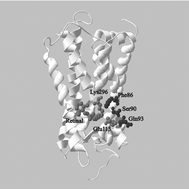Divergent mechanisms for the tuning of shortwave sensitive visual pigments in vertebrates
Abstract
Of the four classes of vertebrate cone visual pigments, the shortwave-sensitive SWS1 class shows the shortest λmax values with peaks in different species in either the violet (390–435 nm) or ultraviolet (around 365 nm) regions of the spectrum. Phylogenetic evidence indicates that the ancestral pigment was probably UV-sensitive (UVS) and that the shifts between violet and UV have occurred many times during evolution. This is supported by the different mechanisms for these shifts in different species. All visual pigments possess a chromophore linked via a

- This article is part of the themed collection: 10th Congress of the European Society for Photobiology

 Please wait while we load your content...
Please wait while we load your content...